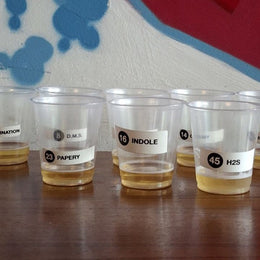
Port wine is one of those wines that everyone always seems to have a bottle of a home, having been gifted one at a special occasion or two. It's a particular style of dessert wine that hails from Portugal, and can come in a variety of types, ranging from red to white, dry to sweet.
Why is it such a popular candidate for gifting? What makes it special? And how do you pick one to try for yourself? Today, let's talk about port wine!
What Is Port Wine?


For all its titular mystery, Port wine is essentially a sweet, fortified wine (most commonly red wine) that is produced in the Douro Valley of Portugal. Fortified wines are wines in which another distilled spirit has been added. The addition halts the base wine's fermentation process and increases its alcohol level. This results in a sweeter, more concentrated product. In the case of Port Wine, the spirit added is by a neutral grape spirit known as aguardente.

The Touriga Francesa grape variety
Port wine can be made with hundreds of varieties of grapes, but the Touriga Nacional variety is generally agreed to be the most desirable port grape, but small yields compounded by difficult growth results in the Touriga Francesa variety to be the more commonly planted grape.
The naming of "Port Wine" came about sometime in the 17th century for the seaport town of Oporto (Also known as Port) where it was traditionally sold and gathered for international export. The Portuguese sure are protective of this wine, and the Douro valley where port wine is produced was defined and established as a protected region in 1756, with the appellation named after the valley. Curiously, this makes Port wine the third officially appellated wine after Chianti (1716) and Tokaj (1730)!

Port is traditionally fermented in shallow, wide troughs called lagars, where fermenting grapes are stepped on.
Types of Port

Port Wines can range from being dry to sweet, red to white, with many variations in between. Generally speaking though, they can be classified into the following mains types:
Reserve Rubies generally have a deeper colour and superior aromatic complexity. It is also often a blend of different years and aged in-bottle.
2. Tawny: Tawny Ports are red wine ports that are aged in wooden barrels. This aging process and its gradual oxidisation imparts a golden-brown color to the port wine and adds complexity of flavor with notes of figs, nuts, and caramel, depending on the length of aging. Tawny Ports are aged for a minimum of three years, while reserve Tawny Ports can be aged for up to seven years.
3. Rosé: Made in the style of Rosé port employs slightly less skin contact than with Ruby Port to achieve a paler color just as in standard rosés, and is a distinct new arrival to the Porto portfolio. A relatively newer addition to the Port wine family, Rosé is a lighter alternative to the traditional ruby and tawny styles, with notes of berries.
4. White: Refers to port wine made from white grapes instead of red grapes. Grape varietals include Rabigato and Viosinho, and white ports often carry stone fruit and citrus notes.
5. Vintage Port: Vintage Port is the crème de la crème of what the Douro’s wine region can offer. It is only made during particular years when the grapes from that year’s harvest are of exceptional quality. Vintage Ports bear the year in which the grapes were grown. Don't expect producers to release a Vintage Port every year, though, as they are only produced in years where producers deem the quality to be high enough.
Vintage ports are aged for a maximum of two and a half years before bottling, and are typically aged for another recommended 10 to 40 years in-bottle before it reaches acceptable drinking age. Despite its age, the period they spend in-cask is relatively short, which helps the resultant wine retain a dark ruby color and fresh fruit flavours.
How does it taste?
Port wines are renowned for its rich, sweet character. The addition of brandy, imparts a distinct sweetness and depth to the wine. Expect flavors of ripe berries, such as blackberries and raspberries, often accompanied by notes of caramel, chocolate, and baking spice.
Aged ports are also known to develop a more complex profile that introduces hints of nuts, dried fruits, and even a touch of balsamic.
That being said, the different versions of Port wine also means a wide array of potential flavors. For example, a young red Port has more berry and chocolate flavors whereas older Tawny Ports have notes that can even including graphite, green peppercorn, tree nuts and butterscotch.
Why is it so valued as a gift?

There's no hard and fast rules or reasons why Port wine is gifted, but there are a few considerable points. For one, the class and prestige that comes with offering an aged vintage, as these wines are typically viewed as more valuable and sophisticated.
With that in mind, also comes the concept of wine investments. Remember, wine ages in-bottle, and some vintage Ports can appreciate in value over time, making them a potentially valuable gift.
From a more general standpoint, Port wine is also very versatile in terms of palate. Port can be enjoyed in various ways - neat, on the rocks, or as a dessert wine, making it extremely approachable regardless of what styles of wine you prefer. Port wine is even preferred in certain recipes, and it's ability to last open for a long time certainly doesn't hurt.
 |
Lok Bing Hong A budding journalist that loves experiencing new things and telling people's stories. I have 30 seconds of coherence a day. I do not decide when they come. They are not consecutive. |







